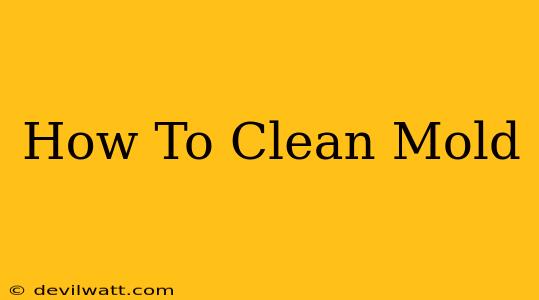Mold. Just the word conjures up images of damp basements and musty odors. But mold isn't just unpleasant; it can also pose serious health risks, especially for those with allergies or respiratory issues. This comprehensive guide will walk you through how to effectively clean mold, ensuring a healthy and safe living environment.
Understanding Mold: Types and Dangers
Before we dive into cleaning methods, it's crucial to understand what we're dealing with. Mold is a type of fungus that thrives in damp, dark, and humid conditions. Several types exist, with varying degrees of toxicity. Some common types include:
- Cladosporium: A common outdoor mold, often found indoors after entering on clothing or through open windows.
- Penicillium: Another prevalent type, known for its ability to produce penicillin, but also capable of causing allergic reactions.
- Aspergillus: This mold can produce potent toxins (mycotoxins) and cause serious health problems.
- Stachybotrys (Black Mold): Often incorrectly associated with all health problems, black mold can be toxic, producing mycotoxins that may cause respiratory issues. However, the presence of any mold warrants attention.
Health Risks: Exposure to mold can trigger a variety of health problems, ranging from mild allergic reactions (sneezing, coughing, itchy eyes) to more severe respiratory infections and, in rare cases, systemic illnesses. Individuals with compromised immune systems are particularly vulnerable.
Assessing the Mold Situation: When to Call a Professional
The first step is assessing the extent of the mold infestation. Small mold patches (less than 10 square feet) can often be cleaned safely by yourself, following the guidelines below. However, larger infestations or mold that has penetrated building materials require professional remediation. This is especially important if you suspect black mold or experience health issues related to mold exposure. Signs you need a professional:
- Mold covers a large area.
- Mold is embedded in walls, floors, or ceilings.
- You notice a musty odor despite cleaning attempts.
- You or your family experience significant health problems.
- You are unsure about the type of mold.
Cleaning Mold Safely: A Step-by-Step Guide
Remember, safety is paramount. Always wear protective gear, including:
- Gloves: Rubber or nitrile gloves to protect your skin.
- Mask: An N95 respirator to prevent inhaling mold spores.
- Eye protection: Safety glasses to protect your eyes.
- Long sleeves and pants: To cover exposed skin.
Cleaning Small Mold Patches (under 10 sq ft):
- Ventilation: Open windows and doors to improve ventilation. Use fans to exhaust air away from the work area.
- Preparation: Gather your cleaning supplies (see below). Cover the surrounding area with plastic sheeting to prevent mold spread.
- Cleaning Solution: Mix a solution of one cup of bleach with one gallon of water. Never mix bleach with ammonia or other cleaning products.
- Application: Apply the solution to the moldy area using a scrub brush. Let it sit for 10-15 minutes.
- Scrubbing: Scrub the area thoroughly to remove the mold.
- Rinse: Rinse the area with clean water.
- Drying: Allow the area to dry completely. Use fans to speed up the drying process.
- Disposal: Dispose of contaminated cleaning materials and rags properly in sealed plastic bags.
Cleaning Supplies:
- Bleach
- Water
- Scrub brush
- Spray bottle
- Plastic sheeting
- N95 respirator
- Rubber or nitrile gloves
- Safety glasses
- Trash bags
Preventing Mold Growth: Proactive Measures
Preventing mold is crucial. Here are some key steps:
- Proper ventilation: Ensure adequate ventilation in bathrooms, kitchens, and other areas prone to moisture. Use exhaust fans.
- Moisture control: Address leaks and water damage promptly. Repair leaky pipes and roofs immediately.
- Regular cleaning: Regularly clean and disinfect areas prone to mold growth.
- Dehumidifiers: Use dehumidifiers in damp areas to reduce humidity levels.
- Regular inspection: Regularly inspect your home for signs of mold growth.
Disclaimer: This article provides general information and should not be considered professional advice. Always consult with a qualified professional for serious mold infestations or if you have health concerns related to mold exposure. This information is for educational purposes only.

